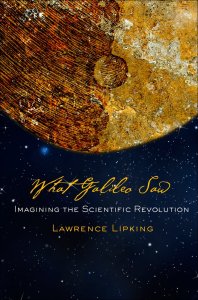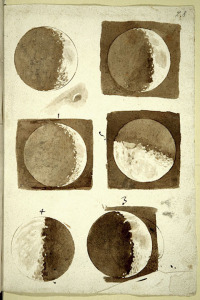Yesterday I had a lovely and long conversation with Dr. Lawrence Lipking about his latest publication, What Galileo Saw: Imagining the Scientific Revolution. Although our chat was nominally for the New Books in Astronomy podcast, it’s the first one I’ve done that’s featured a humanist, and it felt really good to dive into seventeenth-century thoughts on the natural world. The book focuses on the role of imagination in what we’ve come to describe as the Scientific Revolution, and it engages readers to consider the many different versions of this “revolution” that have been proposed and debated for decades (or longer).
One of my favorite parts of the book has everything to do with the title: what Galileo saw through his telescope, what it meant to him, and how he went about sharing it with others. Lipking points out that the etchings of the Moon included in the published version of Sidereus Nuncius are very different from the drawings that Galileo made for himself (see below). Notably, he places a very large crater, which doesn’t correspond to any real feature on the lunar surface and which doesn’t appear in the notebook drawings, prominently on the terminator, where the relationship between light, shadow, and topography is most apparent. Lipking suggests that this deliberate manipulation of his observations amounts to more of a map than a likeness; Galileo is reorganizing the lunar features to structure his readers’ perusal of them and to help them to see as he does.
Another chapter that really jumped out for me deals with the distinction between life and death, and how we recognize the moment of transition, in Shakespeare’s epic tragedy, King Lear. At that critical moment near the end of play, when Lear enters with Cordelia in his arms, no one is sure if she’s alive or dead. Lear calls for a glass and a feather to catch a sign of her breath, and the many different ways that breath and wind come into the play showcase contemporary thoughts and theories of life and death, and how these states are related to the body and soul.
We also spent some time discussing recent historiography of science, and how the notion of genius (something to have or something to be?) has shaped a lot of stories concerned with how we got to now. Lipking sees a rejection of this treatment of history in recent years and a turn toward microhistories rather than grand narratives. As he says, “The stories of exceptional men can be a distraction from the heterogeneous, collaborative activities out of which the history of science emerges,” and I think many (including me) would agree with him on that.
All in all, it was a lovely discussion and a very stimulating book! You can listen to the podcast here, and if you happen to be going to the annual meeting of the History of Science Society later this week, check out Lipking’s talk on Robert Fludd, Thomas Browne, and the history of error (a.k.a. Chapter 7)!



